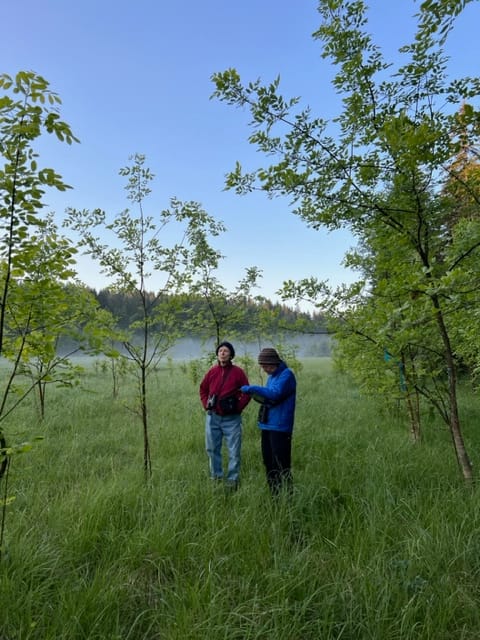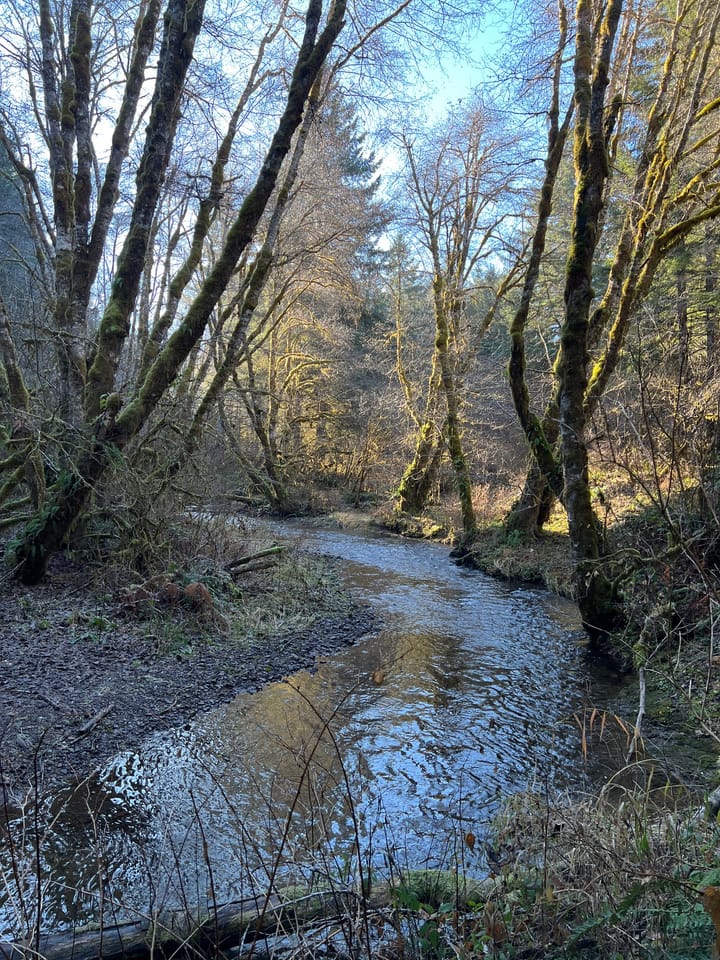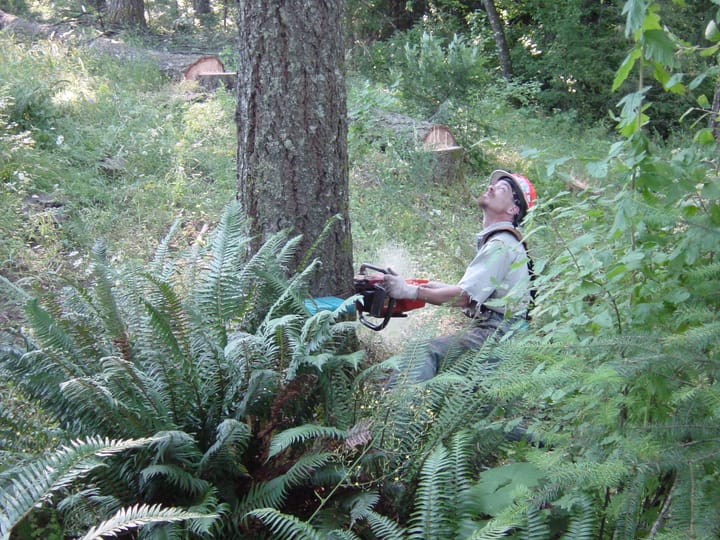Our Time Between

What might Oregon Ash teach us about our present and future?
I can’t seem to shake Oregon ash; the trees fill my attention in ways that they never did before. Travelling through our forests, I find myself noticing them – and often stop to admire and appreciate their details and specialness. All are beautiful, regardless of where they fall along the span from tiny, fresh seedlings to massive elders larger than two spans of my arms can reach around. Traversing our region, out the car’s window easily overlooked stands of ash, tiny to vast, catch my eye and attention. Unlike the ways that ubiquitous stands of Douglas fir blanket our landscape’s rolling hills, the ash opportunistically root and thrive only in those pockets with the special alignment of moisture, soils and seed source. It’s fair to ask what magnetism draws my attention to ash. There are three reasons; two are old and one is new. Ash are remarkable, important and underappreciated trees. These include filling an ecological niche that no other tree come close to touching by favoring wet, poorly drained areas, the ash is a workhorse species for restoration in our forests. Secondly, my attention is drawn by the loveliness of the lumber of the ash. Creamy-colored, tough, but not too heavy, and crossed by strong lines of curving grain, it is a special wood to have in one’s home and life. The paper I write these words on lies on the ash table that is the center of my family’s home. And finally, news of the recently arrival of an ash-killing beetle, emerald ash borer, in our region is sending a shock wave of ecological anticipation through our region. Scientists advise that the odds are very high that essentially all ash in our region will die, possibly within as soon as ten years. From watching human actions move the borer from Asia to eastern North America and west to Colorado, we were well aware of the risk and apparent inevitability. Nevertheless, the news of the beetle’s arrival ten miles from our forest came as a blow. I think of the forest’s web of life as being akin to a complex, colorful tapestry with each species representing a uniquely colored thread. When the threads of ash are pulled from the tapestry, how can the forest avoid becoming a very different and poorer place? For all of these reasons, I find my interest in, affinity, respect and, yes, love, for these trees increasing. As the beetle’s arrival changes my perspective, I make no apologies for stopping often to observe and appreciate the ash – from their furrowed bark against winter’s snow to their unfolding of spring’s bright growth, or the bird’s spiraling down to feed on the tree’s nourishing seeds.
With the ash in our forests, I feel that we have entered what might be considered “the time between”. This period lies between “the time before”, when we knew the beetle’s arrival are highly likely, but it hadn’t happened yet, and “the time after”, a period when ash will no longer be a significant part of the forest; we’ve entered new ground. This time between brings with it a unique poignancy and sweetness; the species is still very much here to be appreciated, but we’re told that it soon will be gone or greatly diminished. The door into “the time between” is marked by our acknowledgement that what lies ahead is inevitable, full of uncertainties and seriously bad. While working to get my head around this time between, it comes to me that this is not the first time between that I have experienced and learned from. I expect that many of you have similar memories. I will never forget the thoughts and feelings whirling during my last visit with my Uncle Don during his time between. Just months after he was diagnosed with pancreatic cancer, he and we knew that his remaining days were few and that this would be our last visit. The diagnosis of a disease with such low odds of surviving it marked, for my uncle, the line between his “time before” to his “time between”. Just as our relationship to ash has taken on new meaning and importance, Don’s transition refocused priorities and sharpened appreciation for both him and his circle of family and friends. Since my uncle’s death, the loss of two good friends and fellow educators, first David and then T.J., to the same disease has taught me about the distinct differences between the three periods: before, between and after.
Recent conversations with a wide range of people motivates me to consider whether this three-stage progression – before, between and after – might apply to larger questions. When I invite these people to share their thoughts and feelings about the outlook for our species, I find that there is much to learn from their opinions. Not surprisingly, the continuum runs from those who see no significant challenges on the horizon to those with gloomy, one-word answers such as bleak, grim, frightening and hopeless. A simple graph helps to clarify key dimensions of the challenges that we face. Two lines may be placed on a graph with amounts being represented on the Y axis and time on the X axis. The line descending from the upper left represents how the earth’s total productive capacity continues to be degraded by human actions. The second line, ascending from the lower left, represents the increasing pressures put on the earth’s systems due to human factors including population growth, increasing per capita consumption and technological changes.
Our challenge is to change human behaviors in ways that keep the lines from crossing. We must bend the lower line from ascending to level to descending. Doing this could lead to the upper line leveling out and ascending. Ideally, our choices to change will prevent the lines from crossing and allow humans – and all life on earth – to slip through the hourglass toward better times. Current science suggests that our changes must be dramatic and must come quickly. If the lines have not already crossed it is all but inevitable that they will. The question of the relationship between the two lines takes on heightened significance because, for the past fifty years my professional calling has been to do all I can to help keep the lines from crossing.
My learning from the emerging science and my conversations with community members stimulates me to explore these four questions:
1 – Does the three stage framework described for ash and cancer logically apply to the multiple, cascading crises that our choices have created? I ask this with the acknowledgement that regardless of what the future holds, some number and version of humans will most certainly endure.
2 – If so, might the framework be helpful as we work to frame our thoughts and actions?
3 – If the framework is applicable, where are we? Are we still in our “time before”, with the possibility of averting the crossing of the lines available to us? Or have we already crossed to our “time between”?
4 – If the framework is applicable, so what? Does question number 3 matter? I see risks in all directions. On the one hand, the belief that we have crossed to our time between might contribute to feelings of nihilism and hopelessness leading to even greater inaction. But on the other hand, the assumption that we’re solidly in our “time before” may further fuel the common misperception that our problems lie in the future and not in the present and that our cleverness will solve the problems, once we set our minds to the task.
Though I am more comfortable asking questions – of myself and others – in hopes of stimulating discussion, I am capable of sharing my provisional answers. The stakes are too high to allow ourselves the indulgence of delusion, but I hope that I am wrong in my conclusions.
1 – Yes, I feel that the framework and metaphor, though not perfect, is applicable, if we’re careful to acknowledge the likelihood that humans will be part of our “time after”.
2 & 4 – Yes, I believe that the framework has enough potential to be helpful to justify exploring it and that this work matters. Just as the success of an ocean navigator depends on knowing where she is as the foundation for know where to go and how to get there, our human choices will be best when informed by accurate assessments of where we are. Abe Lincoln summed in up this way in 1858: “If we could first know where we are and whither we are tending, we could better judge what to do and how to do it.”.
3 – Given the momentum driving our multiple, self-imposed crises and the force of the deceptive stories that so many want to hear, I feel that it is later than we think and acknowledge. If the lines have not already crossed, I find it hard to see how they will not. As shared in Jackson and Jensen’s poorly named, but valuable, An Inconvenient Apocalypse, our future holds a transition to many fewer people living much less consumptive lifestyles and the only question is how hard or soft the landing at the end of the transition will be.
Regardless of “where we are....and whither we are tending..”, there is so much good and important work to be done – we plant more pines and oaks, we work with neighbors to strengthen our communities’ resilience, cultural and ecological, to new and accelerating stresses, we foster understanding of and appreciation for all that we are dependent on – always asking “what do these times and this place ask and demand of us?”. We accelerate forestry that protects and creates habitats for species that most need it. We find joy and inspiration that we know therapeutically counteracts the uncertainties and troubling future that we’ve created.


